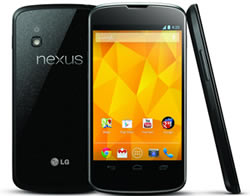Difference between LG Optimus L7 II Dual and Nexus 4
Key difference: The LG Optimus L7 II Dual is a mid-segment phone from LG. The phone is a dual SIM phone. The device features a 4.3 inch IPS LCD, capacitive touchscreen with a resolution of 480 x 800 pixels. It runs on Android v 4.1.2 (JellyBean), which is backed by 1.0 GHz Dual-Core Qualcomm MSM8225 Snapdragon processor and 768 MB of RAM. The Nexus 4 is Google's fourth Nexus-branded Android smartphone. It was produced in collaboration with LG Electronics. The phone runs on the Android 4.2 (Jelly Bean) operating system, which was launched with the phone.
 LG Electronics is a business segment of LG Corporation. LG Corporation is the fourth-largest conglomerate in South Korea. It is known for its various products, such as home appliances, TV and Home Entertainment products, computer products, etc. One of these product segments includes mobile phones, namely the LG Optimus series. Some of the newer phones under this brand include LG Optimus G, LG Optimus L5, LG Optimus L7, etc. LG also recently announced the LG Optimus L7 II Dual.
LG Electronics is a business segment of LG Corporation. LG Corporation is the fourth-largest conglomerate in South Korea. It is known for its various products, such as home appliances, TV and Home Entertainment products, computer products, etc. One of these product segments includes mobile phones, namely the LG Optimus series. Some of the newer phones under this brand include LG Optimus G, LG Optimus L5, LG Optimus L7, etc. LG also recently announced the LG Optimus L7 II Dual.
The LG Optimus L7 II Dual is a mid-segment phone from LG. The phone is a dual SIM phone. The device features a 4.3 inch IPS LCD, capacitive touchscreen with a resolution of 480 x 800 pixels. It runs on Android v 4.1.2 (JellyBean), which is backed by 1.0 GHz Dual-Core Qualcomm MSM8225 Snapdragon processor and 768 MB of RAM. The phone also has Adreno 203 for graphics support. The phone comes with a 2460 mAh Li-Ion battery.
The phone features an 8-megapixel camera with autofocus and LED flash, as well as a secondary VGA camera for video calling and self shots. The primary camera can record videos at 720p resolution with 30fps frame rate, which is quite a decent video resolution. The phone also supports various camera features such as geo-tagging, zoom, Normal shot, Panorama, Continuous shot, Portrait, Landscape, Sports, Night, Sunset, etc.
Some of the unique features on the phone are the Quick Switch Dual SIM Hot Key, which is a dedicated hot key allowing the user to switch between SIM 1 and SIM 2 with the push of a button. The phone also has a Real-Time Quicktranslator, which allows the user to scan a sign, a menu or anything else and translate it into another language. The feature recognizes 44 languages and translates into 64 languages. The LG Optimus L7 II Dual also has Cross-Tasking QSlide feature, which allows the user to simultaneously run two functions on transparent layer on the phone. The device also has an exterior Quick Button that provides quick access to the user’s favorite features and apps.
 Google has also launched its own line of smartphones based on Android, called the Google Nexus. Each device in the Nexus line is produced via collaboration between Google and a leading original equipment manufacturer (OEM) partner.
Google has also launched its own line of smartphones based on Android, called the Google Nexus. Each device in the Nexus line is produced via collaboration between Google and a leading original equipment manufacturer (OEM) partner.
The Nexus devices in general have an advantage over other devices in that the Android in the Nexus devices is pure. I.e. the Android does not have any manufacturer or wireless carrier modifications to it, such as a custom graphical user interface. The Android also has an unlockable bootloader to allow further development and end-user modification, all of which is usually blocked on other Android smartphones.
The Nexus 4 and Nexus 7 are two of the devices available in the Google’s Nexus line. The main difference between them is the fact that the Nexus 7 is a 7 inch tablet, while the Nexus 4 is a smartphone. Also, the Nexus 7 pre-dates Nexus 4.
The Nexus 4 is Google's fourth Nexus-branded Android smartphone. It was produced in collaboration with LG Electronics. The phone features a 1.5 GHz quad-core Snapdragon S4 Pro processor, 2 GB of RAM, 8 or 16 GB of internal storage, front facing 1.3 megapixel camera and an 8 megapixel rear camera and a micro-SIM card tray. The phone runs on the Android 4.2 (Jelly Bean) operating system, which was launched with the phone. The phone also features a new camera technology, called the Photo Sphere. This allows one to take 360 deg Panorama shots.
The information for the detailed table about the two phones has been taken from the LG website, the Google Nexus website and GSMArena.com.
|
|
LG Optimus L7 II Dual |
Nexus 4 |
|
Launch Date |
March 2013 |
November 13, 2012 |
|
Company |
LG |
Google; designed in collaboration with and manufactured by LG Electronics. |
|
Size |
122.2 x 66.6 x 9.7 mm |
133.9 x 68.7 x 9.1 mm (5.27 x 2.70 x 0.36 in) |
|
Display |
4.3 inch IPS LCD, capacitive touchscreen |
True HD IPS Plus capacitive touchscreen, 16M colors |
|
Screen |
WVGA 480 x 800 pixels (~217 ppi pixel density); 16M colors |
768 x 1280 pixels, 4.7 inches (~318 ppi pixel density) |
|
Protection |
- |
Corning Gorilla Glass 2 |
|
Weight |
127g |
139g (4.90 oz) |
|
2G Network |
GSM 850/900/1800/1900 MHz |
GSM 850 / 900 / 1800 / 1900 |
|
3G Network |
UMTS 900/1900/2100 MHz |
HSDPA 850 / 900 / 1700 / 1900 / 2100 |
|
GUI |
Custom UI |
Pure Android |
|
CPU speed |
MSM8225 1.0 GHz Dual-Core |
Quad-core 1.5 GHz Krait |
|
GPU |
Adreno 203 |
Adreno 320 |
|
OS |
Android v4.1.2 JellyBean |
Android OS, v4.2 (Jelly Bean), upgradable to v4.2.2 (Jelly Bean) |
|
Chipset |
Qualcomm MSM8225 Snapdragon |
Qualcomm APQ8064 Snapdragon |
|
RAM |
768MB RAM |
2 GB RAM |
|
SIM Size |
Dual SIM |
Micro-SIM |
|
Internal Memory |
4GB |
8/16 GB storage |
|
Expandable Memory |
microSD, up to 32GB |
None |
|
Sensors |
Accelerometer, proximity, compass |
Accelerometer, gyro, proximity, compass, barometer |
|
Connectivity |
Class 12 GPRS, Class 12 EDGE, Wi-Fi 802.11 b/g/n, Bluetooth v3.0, USB V2.0 HS, 3G |
WiFi 802.11 a/b/g/n, Bluetooth, NFC (Android Beam), Unlocked GSM/UMTS/HSPA+, GSM/EDGE/GPRS, 3G , HSPA+ 42, Wireless charging, SlimPort |
|
Data |
GPRS, EDGE, WLAN, Bluetooth, USB |
WiFi, NFC, GPRS, EDGE, USB |
|
Speed |
HSDPA 7.2Mbps (HSUPA 5.6Mbps) |
DC-HSDPA, 42 Mbps; HSDPA, 21 Mbps; HSUPA, 5.76 Mbps |
|
WLAN |
Wi-Fi 802.11 b/g/n |
Wi-Fi 802.11 a/b/g/n, dual-band, DLNA, Wi-Fi hotspot |
|
Bluetooth |
Bluetooth v3.0 |
Bluetooth v4.0 with A2DP |
|
USB |
USB V2.0 HS |
microUSB (SlimPort) v2.0 |
|
Primary Camera |
8 MP |
8 MP, 3264 x 2448 pixels, autofocus, LED flash |
|
Secondary Camera |
VGA |
1.3 MP |
|
Video |
720 x 480 @ 30fps |
1080p@30fps |
|
Camera Features |
Zoom, Normal, Panorama, Continuous shot, Portrait, Landscape, Sports, Night, Sunset, Geo-Tagging, ISO |
Touch focus, geo-tagging, face detection, photo sphere |
|
Sound Enhancement |
Active noise cancellation with dedicated mic |
SNS integration Active noise cancellation with dedicated mic |
|
Audio supported formats |
MP3, AAC, AAC+, AAC-LC, AMR-NB, WMA |
MP3/WAV/eAAC+/AC3 player |
|
Video supported formats |
MPEG-4 / H.263 /H.264 / DivX |
MP4/H.264/H.263 player |
|
Battery Capacity |
Li-Ion 2460 mAh |
Non-removable Li-Po 2100 mAh battery |
|
Available Colors |
Black, White |
Black |
|
Messaging |
SMS (threaded view), MMS, G'Talk, Email |
SMS(threaded view), MMS, Email, Push Mail, IM, RSS |
|
Browser |
HTML |
HTML5 |
|
Radio |
FM radio |
No |
|
GPS |
GPS, A-GPS |
A-GPS support and GLONASS |
|
Java |
Java via Java MIDP emulator |
Java MIDP emulator |
|
Additional Features |
|
|
Image Courtesy: lg.com, blogs.computerworld.com









Add new comment